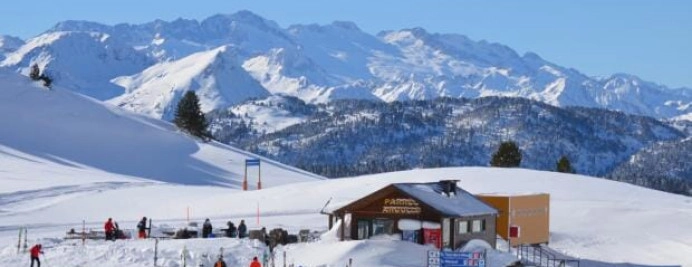Alpine skiing
When one thinks of Baqueira, the first thing that comes to mind is the endless kilometres of ski slopes; more specifically, 162 km of ski slopes, with what is the best snow in the Pyrenees. Since 1964, when the first chairlift was inaugurated, it has been, without a doubt, an essential destination and reference point for all ski lovers. It is the most renowned resort in the country thanks to the quality of its snow, mainly due to its northern orientation.
The resort is divided into four sectors: Bonaigua, Baqueira, Baciver, and Beret. In each sector, there are trails for all levels, although each sector has a different personality and types of trails. What is beyond doubt is that as far as the eye can see, the snow of Baqueira Beret is all yours!
Just a few steps from the hotel, you will find the TC Baqueira ski lift, which, in just a few minutes, will take you up as high as you wish. The highest point of the station measures 2,656 metres, the Tuc de la tuc de la llança, which is in the Bonaigua sector.
TECHNICAL DATA:
Maximum height: 2,610 m
Minimum height: 1,500 m
Slope: 1,110 m
Km of trails: 162 km
Skiable terrain: 2273.00 hectares
Number of trails:
Easy: 49
Intermediate: 46
Difficult: 17
The resort is divided into four sectors: Bonaigua, Baqueira, Baciver, and Beret. In each sector, there are trails for all levels, although each sector has a different personality and types of trails. What is beyond doubt is that as far as the eye can see, the snow of Baqueira Beret is all yours!
Just a few steps from the hotel, you will find the TC Baqueira ski lift, which, in just a few minutes, will take you up as high as you wish. The highest point of the station measures 2,656 metres, the Tuc de la tuc de la llança, which is in the Bonaigua sector.
TECHNICAL DATA:
Maximum height: 2,610 m
Minimum height: 1,500 m
Slope: 1,110 m
Km of trails: 162 km
Skiable terrain: 2273.00 hectares
Number of trails:
Easy: 49
Intermediate: 46
Difficult: 17
EXPERIENCIAS CERCANAS
The Aran Valley in winter does not only mean snow, skiing, and sports. The valley hides one of the most precious architectural treasures of the Pyrenees.
Just a few kilometres from the Hotel MIM Baqueira, you can enjoy the lovely ROUTE OF BEAUTIFUL ROMANESQUE CHURCHES, built between the 12th and 13th centuries, perfectly maintained throughout time, which are notable for their architecture, frescoes, and wood carvings. A total of 33 of the villages in the Aran Valley have their own Romanesque treasures, but we recommend a tour of the five that, for us, are the most characteristic.
Departing from the hotel in the direction of Vielha, you will stop in Salardú, Unha, Arties, Bossost and Vielha.
In Salardú, you will visit Sant Andreu de Salardú;, dating back to the 13th century, with murals from the 17th century and the Christ of Salardú, from the 12th century, carved in the same village.
A few minutes from here, you will find a detour on the right side of the road. This will take you to the little village of Unha, Santa Eulalia de Unha, a beautiful church where paintings and frescoes with what was the Christ Pantocrator still remain along with a bell tower that was added later in the 18th century. In Unha, you can also visit the Snow Museum.
Back on the main road, in the lovely village of Arties, you will find the beautiful church of Santa Maria de Arties, which has been declared a national monument. It is certainly worth getting lost in the narrow streets of this village.
You continue your journey a few kilometres past Arties, passing Vielha, and continuing along the N-230 towards France. You will reach Bossost, Era Mair de Diu dera Purificación, which is one of the best examples of Aranese Romanesque architecture. In addition, it is the only town in the Aran Valley that still maintains their traditional Easter processions.
On your way back to the hotel, you will stop in Vielha, the capital of Aran, where, apart from walking around its historical centre and visiting its shops, you will find, right in the middle of the village, Sant Miqueu de Vielha, an example of the transition from Romanesque to Gothic, completed in the 13th century.
No matter which village you are in at lunchtime, you cannot pass up the opportunity to try the most characteristic dish of the Aran Valley, the OLLA ARANESA, one of the oldest documented soup dishes in Europe. It is impossible to choose only one restaurant, as this forms part of Aranese heritage. So, we will share the recipe with you:
Ingredients
Beef and ham bones, pork spine, 1/4 kg chicken, 1/4 kg pork, 100 g. beef, oxtail, or duck (optional), carrots and cabbage, chickpeas and white beans, 1 small cup of rice, noodles (not too thick), black pudding, 1 egg, salt, pepper, parsley, garlic, and breadcrumbs.
Preparation
Mix the beef and pork, previously minced, in a bowl. Add the egg, salt, pepper, garlic, parsley, and finally the breadcrumbs. Use a fork to work the mixture into a smooth ball. Sprinkle with flour until the meatball is completely covered. In a frying pan containing hot oil, brown the meatball and set aside. Meanwhile, prepare a broth with the remaining meat. When it begins to boil, add the meatball and allow it to cook for approximately two hours. After that, add the vegetables and beans (pre-cooked) and let this cook for another hour. Add the noodles, rice, and black pudding, adjusting the salt level. After about 20 minutes, the olla will be ready. The longer it is allowed to stand, the better it will taste. The meat is served on a platter to accompany the Olla Aranesa.
Just a few kilometres from the Hotel MIM Baqueira, you can enjoy the lovely ROUTE OF BEAUTIFUL ROMANESQUE CHURCHES, built between the 12th and 13th centuries, perfectly maintained throughout time, which are notable for their architecture, frescoes, and wood carvings. A total of 33 of the villages in the Aran Valley have their own Romanesque treasures, but we recommend a tour of the five that, for us, are the most characteristic.
Departing from the hotel in the direction of Vielha, you will stop in Salardú, Unha, Arties, Bossost and Vielha.
In Salardú, you will visit Sant Andreu de Salardú;, dating back to the 13th century, with murals from the 17th century and the Christ of Salardú, from the 12th century, carved in the same village.
A few minutes from here, you will find a detour on the right side of the road. This will take you to the little village of Unha, Santa Eulalia de Unha, a beautiful church where paintings and frescoes with what was the Christ Pantocrator still remain along with a bell tower that was added later in the 18th century. In Unha, you can also visit the Snow Museum.
Back on the main road, in the lovely village of Arties, you will find the beautiful church of Santa Maria de Arties, which has been declared a national monument. It is certainly worth getting lost in the narrow streets of this village.
You continue your journey a few kilometres past Arties, passing Vielha, and continuing along the N-230 towards France. You will reach Bossost, Era Mair de Diu dera Purificación, which is one of the best examples of Aranese Romanesque architecture. In addition, it is the only town in the Aran Valley that still maintains their traditional Easter processions.
On your way back to the hotel, you will stop in Vielha, the capital of Aran, where, apart from walking around its historical centre and visiting its shops, you will find, right in the middle of the village, Sant Miqueu de Vielha, an example of the transition from Romanesque to Gothic, completed in the 13th century.
No matter which village you are in at lunchtime, you cannot pass up the opportunity to try the most characteristic dish of the Aran Valley, the OLLA ARANESA, one of the oldest documented soup dishes in Europe. It is impossible to choose only one restaurant, as this forms part of Aranese heritage. So, we will share the recipe with you:
Ingredients
Beef and ham bones, pork spine, 1/4 kg chicken, 1/4 kg pork, 100 g. beef, oxtail, or duck (optional), carrots and cabbage, chickpeas and white beans, 1 small cup of rice, noodles (not too thick), black pudding, 1 egg, salt, pepper, parsley, garlic, and breadcrumbs.
Preparation
Mix the beef and pork, previously minced, in a bowl. Add the egg, salt, pepper, garlic, parsley, and finally the breadcrumbs. Use a fork to work the mixture into a smooth ball. Sprinkle with flour until the meatball is completely covered. In a frying pan containing hot oil, brown the meatball and set aside. Meanwhile, prepare a broth with the remaining meat. When it begins to boil, add the meatball and allow it to cook for approximately two hours. After that, add the vegetables and beans (pre-cooked) and let this cook for another hour. Add the noodles, rice, and black pudding, adjusting the salt level. After about 20 minutes, the olla will be ready. The longer it is allowed to stand, the better it will taste. The meat is served on a platter to accompany the Olla Aranesa.
Additional ways to enjoy the snow
When we think of snow, we increasingly think of all the other opportunities other than alpine skiing that the winter holidays offer us.
There is no better environment to enjoy them than Baqueira. The resort itself offers countless possibilities, from heliskiing, Nordic and Telemark skiing, ski mountaineering, snowshoeing, sledging with dogs or horses, to snowmobiling;
NORDIC SKIING: The resort has two ski circuits: a Nordic one measuring 7 km in Pla de Beret and a less well-marked one measuring about 40 km. A ski pass is not required to enjoy these routes and as an interesting fact, every February there is a race with more than 1500 participants.
SKI MOUNTAINEERING: The number of ski mountaineers has increased over recent years. Hiking and climbing the highest peaks is no longer just a task for mountaineers. For this reason, Baqueira Beret has prepared 4 routes for these athletes, three in the Beret sector and one in La Bonaigua. When practising this sport, you should always be aware of the snow levels and the risk of avalanches. These routes are open during the hours that the resort is open
Beret sector:
Molins circuit, for beginners. Originating in the Pla de Beret itself, it runs parallel to the outer edge of the Pista Molins. It is 2,354 metres long and has a 350 metres slope.
The Barlongueta circuit, which is medium level, starts at the Beret car park and runs parallel to the outer edge of the Barlongueta track. It is 2,786 metres long and has a 488 metres slope.
The Tuc del Rosari and Tuc de Baciver circuitis for experts. A portion of the Orri car park runs through a carefully maintained area up to the Tuc del Rosari, at 2,594 m. (or up to the Tuc de Baciver, at 2,644 m.), with a slope of 744 and 794 metres, respectively.
The Bonaigua sector
The Muntanya circuit. This route begins at the Cap del Port restaurant and climbs parallel to the Bonaigua track to an altitude of 2,510 metres. It is 2,600 metres long and has a 438 metres slope.
There is no better environment to enjoy them than Baqueira. The resort itself offers countless possibilities, from heliskiing, Nordic and Telemark skiing, ski mountaineering, snowshoeing, sledging with dogs or horses, to snowmobiling;
NORDIC SKIING: The resort has two ski circuits: a Nordic one measuring 7 km in Pla de Beret and a less well-marked one measuring about 40 km. A ski pass is not required to enjoy these routes and as an interesting fact, every February there is a race with more than 1500 participants.
SKI MOUNTAINEERING: The number of ski mountaineers has increased over recent years. Hiking and climbing the highest peaks is no longer just a task for mountaineers. For this reason, Baqueira Beret has prepared 4 routes for these athletes, three in the Beret sector and one in La Bonaigua. When practising this sport, you should always be aware of the snow levels and the risk of avalanches. These routes are open during the hours that the resort is open
Beret sector:
Molins circuit, for beginners. Originating in the Pla de Beret itself, it runs parallel to the outer edge of the Pista Molins. It is 2,354 metres long and has a 350 metres slope.
The Barlongueta circuit, which is medium level, starts at the Beret car park and runs parallel to the outer edge of the Barlongueta track. It is 2,786 metres long and has a 488 metres slope.
The Tuc del Rosari and Tuc de Baciver circuitis for experts. A portion of the Orri car park runs through a carefully maintained area up to the Tuc del Rosari, at 2,594 m. (or up to the Tuc de Baciver, at 2,644 m.), with a slope of 744 and 794 metres, respectively.
The Bonaigua sector
The Muntanya circuit. This route begins at the Cap del Port restaurant and climbs parallel to the Bonaigua track to an altitude of 2,510 metres. It is 2,600 metres long and has a 438 metres slope.
Location & Contact
Address
C. Perimetrau, s/n , Urb. Val de Ruda, 25598, Baqueira, Lleida, España









